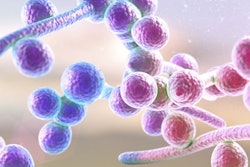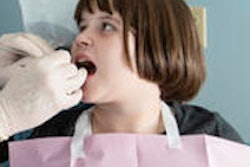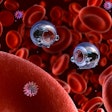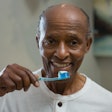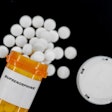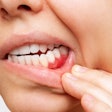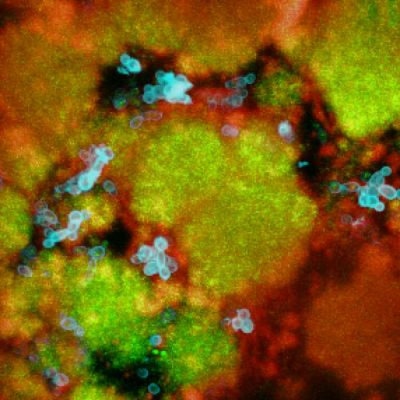
Early childhood caries (ECC) may result from a nefarious partnership between a bacterium and a fungus, according to a new study in the journal Infection and Immunity (February 24, 2014).
Infection by Streptococcus mutans and Candida albicans together doubled the number of caries and boosted their severity several-fold in rats, the University of Pennsylvania researchers found.
ECC can be so severe that treatment frequently requires surgery in a hospital, they noted.
The bacterium S. mutans has long been assumed to be the sole microbial culprit, but the researchers noticed that the fungus C. albicans was almost always present in plaque in ECC. S. mutans sticks to the surfaces of teeth by converting sugars to a sticky glue-like material called extracellular polysaccharide (EPS). In the mouth, Candida adheres mainly to cheek and tongue, but had rarely been seen in dental plaque.
 This figure (a cross section of the biofilm) depicts S. mutans microcolonies (in green) together with C. albicans (in blue) all surrounded and enmeshed in extracellular polysaccharides matrix (in red). Image courtesy of Hyun (Michel) Koo, University of Pennsylvania.
This figure (a cross section of the biofilm) depicts S. mutans microcolonies (in green) together with C. albicans (in blue) all surrounded and enmeshed in extracellular polysaccharides matrix (in red). Image courtesy of Hyun (Michel) Koo, University of Pennsylvania."However, we noticed that Candida was very frequently observed in plaque from patients who have early childhood caries," said study co-author Hyun (Michel) Koo, DDS, PhD, a professor of orthodontics at the University of Pennsylvania School of Dental Medicine. "We were puzzled! Candida usually does not associate with S. mutans, nor does it colonize teeth very effectively."
The researchers discovered that the "exoenzyme" that S. mutans uses to react with sugar to produce EPS also enables Candida to produce a glue-like polymer in the presence of sugar, allowing it to adhere to teeth and to bind S. mutans, two abilities it otherwise lacks. Under these circumstances, the fungus now contributes the bulk of the plaque.
Dr. Koo has spent 15 years studying how microbes construct the biofilms, also known as plaque, that have plagued teeth since Homo sapiens invented agriculture, bringing large quantities of starch into the diet. (Caries are common in Neolithic skeletons but virtually absent from our Paleolithic ancestors.)
The combination of the two organisms led to a greatly enhanced production of the glue-like polymer, drastically boosting the ability of the bacterium and the fungus to colonize the teeth, increasing the bulk of the biofilms and the density of the infection, Dr. Koo said.
All that led to greatly elevated accumulation next to the teeth of the acid that dissolves enamel, leading to caries formation.
"This represents a truly unique physical interaction where a bacterially produced product attaches to and functions on the surface of an organism from another kingdom, converting this normally innocuous (with respect to teeth) fungus into a fierce stimulator of cariogenic biofilm formation," he said.
That observation supports his hypothesis that ECC in toddlers results from infection by both organisms, with frequent exposure to sucrose.
The study could open the way to test agents to prevent ECC and possibly preventing children from acquiring the infection, the study authors concluded.




